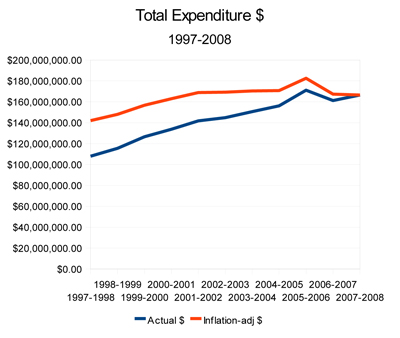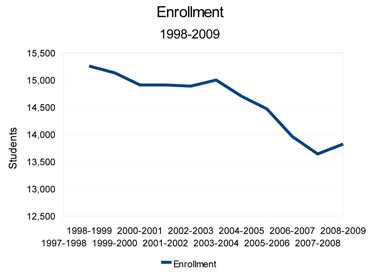Hello all you lonely people who have nothing better to do than read a live blog about the Peoria City Council meeting. 🙂 Mayor Ardis is not here this evening, so Ryan Spain is filling in as Mayor Pro Tem. As always, I’ll be updating this post throughout the evening, so refresh often. Here’s tonight’s agenda:
Monthly Archives: September 2010
Bradley’s investment in Main Street Commons could be over $1M
Bradley isn’t saying exactly how much they invested in Main Street Commons, but they are saying this, from the Bradley University Scout:
Vice President for Business Affairs Gary Anna said Main Street Commons construction had been delayed due to the struggling economy, but Bradley had a hand in funding the first phase of building. “We took a piece of our endowment that had been set aside,” he said. “The preliminary stage of the project is $12 million, and we gave less than 10 percent of that. The money is not coming from a source that would construct a building on campus or for equipment for labs, so we’re not shortchanging the students. There is a return on our end that will go back to the endowment.”
Less than 10% of $12 million is any amount up to $1,199,999.99.
Panetta criticizes Block the Bonds effort
Journal Star reporter Gary Panetta recycled his blog post of Sept. 2 (also see his follow-up post Sept. 3) as a print article on Sunday. He thinks the Block the Bonds group is “nitpicking and making much over nothing much at all and potentially mucking up a project that could turn out to be a real turning point for the city’s art scene.” I’ll let my comments on the two blog posts stand as my response to his article. I’ve reprinted them below the jump for archival purposes.
Super Saver Shipping
I recently ordered some books from Amazon.com. Having no particular need to get them quickly, I chose the “Super Saver Shipping.” By “Super Saver,” they mean, of course, “free.” The price you pay for “free” shipping is a longer delivery time. The range is 5-9 days, according to Amazon.
On the one hand, you would expect a 5-9 day delivery window to be very unpopular since we live in an age of instant gratification. But on the other hand, it’s free, and we live in an age where everyone wants something for nothing, or at least as cheap as they can possibly get it even if it means the product was fabricated by malnourished child slaves in a third-world ghetto. But on the third hand (metaphorically speaking, of course — try not to conjure up images of a freakish person with three hands — although, if those third-world child slaves had three hands, I bet their employer would increase their production quota by 50% — but I digress), we’re talking about people who order books after all, which implies someone who is in no particular hurry to acquire information in the first place.
So, the order was placed August 22. The order was shipped August 26. This indicates that “Super Saver Shipping” also means “Super Slow Handling.” But that’s okay because, as I said, I’m in no particular hurry. Looking at the tracking information, the first line shows:
“August 26, 2010 03:41:00 AM [Location:] US [Event details:] Shipment has left seller facility and is in transit.”
The next line shows:
“August 30, 2010 03:49:20 PM [Location:] Fedex Smartpost Indianapolis IN US [Event details:] Arrival Scan”
So, from the time it left the seller facility until it arrived in Indianapolis, it took four more days. This may or may not be reasonable, depending on where the “seller facility” is. That location is evidently a closely-guarded secret since it is not listed in the tracking information, except to say that it did originate in the U.S. Since Amazon.com is headquartered in Seattle, Washington, I can only assume some administrative assistant there was given my package and told to drive it to the FedEx Smartpost facility in Indianapolis.
Of course, the question then becomes, what is “FedEx Smartpost”? According to their website: “When you need to ship low-weight packages to residential customers, consider efficient, economical FedEx SmartPost service. By utilizing the United States Postal Service® (USPS) for final delivery, FedEx SmartPost reaches every U.S. address, including P.O. boxes and military APO and FPO destinations. You can even use FedEx SmartPost to ship to Alaska, Hawaii and all U.S. territories.” According to Wikipedia, “The resulting service is one that is less expensive than FedEx Ground, but more expensive than regular mail.”
If I understand this service right, you’re basically paying FedEx to put your package in the U.S. Mail for you. That way you can enjoy both the added expense of Federal Express handling and the inefficiency of the post office. I’m not exactly sure why Amazon would want to spend extra to send a package for free with the slowest possible transit time, but hey, they seem to be successful doing so. Who am I to question it?
The next line shows:
“August 30, 2010 11:51:00 PM [Location:] — [Event details:] Arrival Scan”
Eight hours later, it arrived at a different part of the building. For a company that is able to send packages around the world in a day, their interoffice mail system is astonishingly slow.
“August 30, 2010 11:51:48 PM [Location:] Fedex Smartpost Indianapolis IN US [Event details:] Departure Scan”
Forty-eight seconds later, it was dispatched from Indianapolis.
“August 31, 2010 10:10:00 AM [Location:] Peoria IL US [Event details:] Arrival Scan”
Nine days after the order date, as promised, my package arrives in Peoria. But wait….
“August 31, 2010 10:41:00 AM [Location:] Peoria IL US [Event details:] Shipment forwarded to a different delivery address
August 31, 2010 12:42:00 PM [Location:] Peoria IL US [Event details:] Shipment forwarded to a different delivery address”
Now it gets more complicated. The package was sent to my work address. And my employer is moving. There are actually two facilities with two different addresses where I work, and while one of the facilities had in fact moved already, the other one hasn’t. I had the package sent to the facility where I am still working, but unfortunately, my employer is having mail from both addresses forwarded to the new facility.
Well, not to worry, it’s just on the other side of town. Forwarding should only take an extra day.
“September 9, 2010 08:18:00 AM [Location:] Forest Park IL US [Event details:] Arrival Scan”
No, I haven’t left anything out. This is the very next line on the tracking sheet. In order to forward a letter from one side of town to the other, thanks to the efficiencies of modern postal technology, the package has to go to a centralized sorting facility in Forest Park, a suburb of Chicago.
Whereas it took an administrative assistant only four days to get from Seattle to Indianapolis with my package, the Post Office managed to take nine days to ship my package 160 miles. I can only assume that it was taken by a mail carrier on foot. Given that average human walking speed is 3 miles per hour, a mail carrier walking six hours a day would have gotten my package from Peoria to Forest Park in nine days. You have to admire these civil servants’ dedication.
“September 10, 2010 03:39:00 AM [Location:] Des Moines IA US [Event details:] Arrival Scan”
The Forest Park sort facility, obviously mistaking the Peoria, IL, address for Peoria, IA, sent my package off to the sorting facility in Des Moines. I thought that was silly at first, but after doing a little research I was surprised to find that there is not one, but two Peorias in Iowa — one in Wayne County and one in Mahaska County.
I’m never getting that package.
WCBU news misses the mark
WCBU News this morning said that a successful effort to stop the issuance of general obligation bonds for the museum would be “a moot point” because the County Board could just use a different kind of bond to fund the project. Apparently the reporter fails to understand that the type of bond being used is the issue. If we were to stop the issuance of general obligation bonds and the County issued revenue bonds instead, then we will have prevailed. Hardly a “moot point.”
Usually WCBU does a good job reporting the news, but this story sorely missed the mark.
Chuck Weaver to announce run for City Council
From my inbox:
MEDIA ADVISORY
A lifelong Peorian and local businessman, Chuck Weaver, is announcing his candidacy for an at-large seat on the Peoria City Council. Join us at 2:00 on Tuesday, September 14th at the Main Street Commons development site on Main Street in Peoria to meet Chuck and find out why he is running.
Harding to ask County Board to put bond referendum on ballot (UPDATED)
From a press release:
Peoria County Board member Brad Harding will be offering an amendment at the Thursday, September 9, 2010 monthly Peoria County Board meeting to place the museum bond referendum on the February or April ballot by a direct vote of the Peoria County Board.
The passage of the new bonding instruments offers this is an alternative to gathering 9,849 petition signatures which is the other way offered by the August 2010 affirmative Peoria County Board meeting vote.
I wonder if a majority of the Board will support giving a voice to the citizens of Peoria County.
UPDATE: Assistant State’s Attorney Bill Atkins says Harding cannot offer an amendment tonight. Here is his e-mail to Brad:
The public hearings for the bond issues for Bel-wood and the museum project are not action items for the County Board. These are opportunities for the public to be heard concerning these matters, not opportunities for Board Members to offer their own views of what should be done. Offering amendments to the actions previously taken by the Board on each of these items would be a violation of the Open Meetings Act because no action item has been placed on the agenda and notice has not been given to the public. Since 48 hours public notice must be given for action to be taken it is impossible to properly notice your proposed amendments for tonight’s meeting.
Even if your proposed amendments complied with the Open Meetings Act, I don’t think they are authorized by law. Backdoor referenda are a possibility for each of these bonds and if a sufficient number of citizens want a referendum on either or both of these bonds, then they can petition for such a referendum. The County Board has to be specifically authorized by law to place a binding referendum on the ballot and I am not aware of any law that would authorize such a referendum at this point in the process of authorizing these two bond issues.
William W. P. Atkins
Chief Civil Assistant State’s Attorney
Peoria County Courthouse
324 Main Street
Peoria IL 61602
Museum bonds hearing tonight
The Peoria County Board will meet this evening at 6 p.m. in the County Courthouse, 324 Main Street, County Board Room 403. On tonight’s agenda is a required public hearing for the $41.6 million debt (bonds) to construct the proposed Peoria Riverfront Museum. If you ever wondered whether such public hearings were perfunctory, just remember that they already had the museum groundbreaking two days ago. That’s how highly they regard your opinion.
Nevertheless, this is an opportunity to tell the County Board — on the record — how you feel about these bonds. I would encourage all those who are concerned about this debt to attend the meeting tonight and make your voice heard. If you haven’t signed the petition yet, you can do so at the meeting tonight — members of the Block the Bonds group will be there collecting signatures.
Operational expense goes up as enrollment goes down in D150
I’ve been looking at the Interactive Illinois Report Card for District 150. Here are the total expenditures of District 150 for a period of eleven years, 1997-2008; in the last column, I converted all the amounts into constant 2008 dollars to make it easier to compare apples to apples:
|
 |
Looking at the inflation-adjusted dollars, and acknowledging that it does appear to have started a downward trend, you’ll nevertheless notice that from 1997 to 2008, operational expense per student has increased over 17%. However, if you look at enrollment over roughly the same period (1998-2009), the trend is different:
|
 |
I wanted to include the 2008-2009 data so you could see that enrollment did go up slightly that year. Nevertheless, enrollment from 1998 through 2009 fell by 9.4%. As a result, operating expense per student has increased over 24% — from $9,184 in 1997 (in inflation-adjusted dollars) to $11,398 in 2008.
Questions: Why have operational expenses continued to climb while enrollment has been decreasing? Why are expenses $25.4 million more in 2008 than in 1997 (in inflation-adjusted dollars) when enrollment fell by over 1,400 students? Where is the money going?
“The Cartel” touts vouchers, school choice
 I went to see “The Cartel” at The Peoria Theater over the weekend (it’s playing through Sept. 16). From a technical standpoint, I was immediately disappointed that it was a DVD played over an LCD projector. When I go to the theater, I expect to see an actual film. I recognize that many films today use digital cinematography, but 4K or even 2K digital film resolution is a far cry from a standard-def TV signal output to an LCD projector.
I went to see “The Cartel” at The Peoria Theater over the weekend (it’s playing through Sept. 16). From a technical standpoint, I was immediately disappointed that it was a DVD played over an LCD projector. When I go to the theater, I expect to see an actual film. I recognize that many films today use digital cinematography, but 4K or even 2K digital film resolution is a far cry from a standard-def TV signal output to an LCD projector.
But leaving aside that pet peeve and getting into the actual content, “The Cartel” breaks no new ground. You’ll find the usual complaints against public education in this country — and the usual solutions. Some critiques are better than others. Teachers unions and tenure are criticized for protecting bad teachers and not adequately rewarding good teachers (good critique). Top-heavy administration and patronage hiring are blamed for keeping money away from the classroom (good critique). One of the interviewees claims there’s an inverse correlation between the quality of the school district and the number of luxury cars parked in the administration lot (ridiculous critique).
The film focused almost exclusively on New Jersey public schools, but the filmmaker stated emphatically this wasn’t a New Jersey documentary, but rather a documentary on the entire American public school system. He apparently feels the problems in New Jersey are a perfect example of what’s wrong everywhere. By and large, that’s probably true, although earlier in the movie he had some nice things to say about Maryland public schools, so evidently not all the problems addressed in the film are universal.
As for solutions, there seemed to be an implication that teachers unions have to be busted. But the most overt solution presented was school vouchers. A good part of the film was spent presenting and defending the use of vouchers. He deals head-on with the usual criticisms of voucher systems, and steadfastly defends the redeeming power of free-market forces (if kids get vouchers, the free market will create lots of high-quality private schools, the public school system will improve because they’ll want to compete with the private schools, etc.).
From a film-making standpoint, I thought the music and graphics were good, as was the editing. The movie is broken up into chapters, and each chapter forms a cohesive unit that is well-put-together and keeps your interest. However, the chapters don’t feel like they tell a story when put together. They feel more like discrete issues presented in no particular order. In other words, there’s not a sense of flow to the film. While most of the film was well-argued (whether you agreed with the arguments or not), some parts of the film felt a little too heavy-handed and propaganda-ish.
All in all, I would recommend seeing this documentary. I think it would make a good jumping-off point for discussion on the issues surrounding public education.икони
